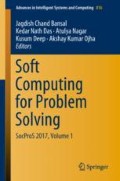Abstract
Traffic safety has become one of the major concerns in most of the countries with extensive road networks. With the ever-increasing traffic and its various types, it has become increasingly difficult to check if the road network can sustain the surge. To evaluate the efficiency and safety of a network, several factors such as speed, vehicular composition, traffic volume are required. Data collection for calculating each of these factors is time-consuming. Most of the current activities in the area of intelligent transportation systems involve the collection of data through various sources such as surveillance cameras, but the collection alone is not sufficient. It requires a lot of time to process this data and determine the safety level of the road network which becomes manifold for a country with a vast network like India. It is a necessity to expand the use of intelligent transportation for the processing of the data. To achieve this initially, it is required to have traffic flow data. Therefore, high-resolution video cameras were placed at vantage points approximately 100–150 m away from the center of intersection locations. Two such intersections were selected from the National Capital Region (NCR) of India. Traffic flow-related data was recorded from 10 am to 4 pm during good weather condition. The obtained videos were then processed to segregate different types of vehicles. The proposed algorithm deals with the vehicles which are up to 70% occluded. A CNN-LSTM (Krizhevsky et al. in Advances in neural information processing systems, pp 1097–1105, 2012 [6]) model is trained for the recognition of a vehicle. Following this, a minimal cover volume algorithm is developed using bi-grid mapping for classifying vehicles and evaluating various parameters such as base center, orientation, and minimizing error due to occlusion. The proposed algorithm is based on machine learning, and it can estimate the required parameters with minimal human assistance and accuracy of 95.6% on test video and 87.6% on cifar-100 for object detection.
Access this chapter
Tax calculation will be finalised at checkout
Purchases are for personal use only
References
Simonyan, K., Zisserman, A.: Very deep convolutional networks for large-scale image recognition. In: ICLR (2015)
Goodfellow, I.J., Warde-Farley, D., Mirza, M., Courville, A., Bengio, Y.: Maxout networks. arXiv:1302.4389 (2013)
Sermanet, P., Eigen, D., Zhang, X., Mathieu, M., Fergus, R., LeCun, Y.: Overfeat: integrated recognition, localization and detection using convolutional networks. In: ICLR (2014)
Erhan, D., Szegedy, C., Toshev, A., Anguelov, D.: Scalable object detection using deep neural networks. In: CVPR (2014)
Szegedy, C., Reed, S., Erhan, D., Anguelov, D.: Scalable, high-quality object detection. arXiv:1412.1441v2 (2015)
Krizhevsky, A., Sutskever, I., Hinton, G.E.: Imagenet classification with deep convolutional neural networks. In: Advances in Neural Information Processing Systems, pp. 1097–1105 (2012)
Sainath, T.N., Vinyals, O., Senior, A., Sak, H.: Convolutional, long short-term memory, fully connected deep neural networks. In: 2015 IEEE International Conference on Acoustics, Speech and Signal Processing (ICASSP), pp. 4580–4584. IEEE (2015)
Nokandeh, M.M., Ghosh, I., Chandra, S.: Determination of passenger-car units on two-lane intercity highways under heterogeneous traffic conditions. J. Transp. Eng. 142(2), 04015040 (2015)
World Health Organization (WHO): World Report on Road Traffic Injury Prevention, WHO, Geneva, http://www.who.int/violence_injury_prevention/publications/road_traffic/world_report/en/ (2004)
NTDPC ~ Vol-02 Part1 ~ Ch02.indd26 page30, http://planningcommission.nic.in/sectors/NTDPC/volume2_p1/trends_v2_p1.pdf
Author information
Authors and Affiliations
Corresponding author
Editor information
Editors and Affiliations
Rights and permissions
Copyright information
© 2019 Springer Nature Singapore Pte Ltd.
About this paper
Cite this paper
Mittal, A., Gupta, M., Ghosh, I. (2019). Data Extraction from Traffic Videos Using Machine Learning Approach. In: Bansal, J., Das, K., Nagar, A., Deep, K., Ojha, A. (eds) Soft Computing for Problem Solving. Advances in Intelligent Systems and Computing, vol 816. Springer, Singapore. https://doi.org/10.1007/978-981-13-1592-3_16
Download citation
DOI: https://doi.org/10.1007/978-981-13-1592-3_16
Published:
Publisher Name: Springer, Singapore
Print ISBN: 978-981-13-1591-6
Online ISBN: 978-981-13-1592-3
eBook Packages: Intelligent Technologies and RoboticsIntelligent Technologies and Robotics (R0)

